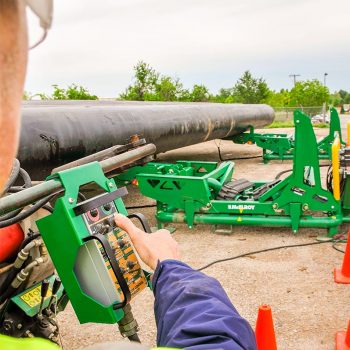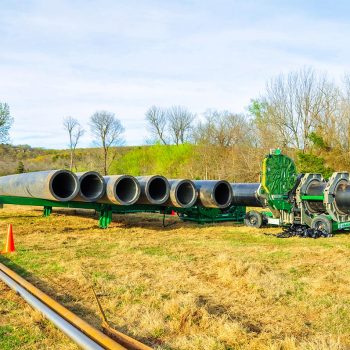Today’s most advanced fusion machines are purposely designed with features to make them easy and efficient for operators to use. When paired with pipe-handling equipment designed specifically to complement these machines, jobsites become even more productive, saving time and money.
One of the great benefits of productivity is that it goes hand-in-hand with safety. Most accidents occur during pipe handling as workers are loading and unloading large, heavy pipe or when additional construction equipment is brought in to move big and unwieldy pipe with other people in close proximity.
Simplifying the riskier parts of the fusion process is a key part of the design phase for today’s best fusion equipment and pipe handling tools.
Loading
Pipe-handling equipment consisting of a series of pipe racks and powered pipe stands that holds a day’s worth of pipe in a single location is a huge win both in terms of safety and productivity.
A single 54″ DR 25 high-density polyethylene pipe stick weighs around three tons. Safety concerns arise when excavators or cranes are used to lift pipe. Heavy pipe dangling overhead can be a dangerous proposition especially when a single lifting strap is used with multiple workers below.
Instead of dedicating heavy machinery to lift, align, load and hold a stick of pipe to be fused, a good pipe-handling system can do all the work. A single operator can dispense the pipe onto the powered pipe stands, maneuver the pipe into alignment and insert pipe into the fusion machine with the use of a remote control.
The pipe racks are purposefully designed with an adjustable incline that allows gravity to feed the pipes to the dispenser. Each powered pipe stand allows for up to 24 inches of lateral adjustment and 34 inches of vertical adjustment. The operator controls the powered pipe stands to move and align the pipe with the fusion machine. Powered rubber tracks feed the aligned stick of pipe into the fusion machine efficiently, safely and with less risk of damage to the equipment.
Pairing a good pipe handing system with pipe fusion works especially well on jobsites where pipe is staged in one area, fused and pulled into place. Pipe only has to be handled by heaving machinery once and that is prior to the fusion when it is being loaded from the delivery truck to the racks of the pipe handling system. Pipe also stays cleaner and off the ground with less potential for damage.
One Operator
The best fusion machines today are designed around the goal of having strictly one operator. The controls are laid out so that a single operator can perform every step of the fusion process. These controls are located in a logical fashion so that the operator has a clean line of sight of where the valve is actuated to the mechanism that the valve controls.
Another advantage of having only one operator is that all operations are done from a central point and on one side of the machine. This eliminates the possibility of having workers on the back side of the machine where visibility is limited by the pipe, heater and facer.
Simple is better. Minimizing the clutter of moving equipment, pipe and people in close proximity is always an improvement. This helps reduce common accidents like being struck by object or caught between objects. Keeping it clean and simple means there is less opportunity for error and miscommunication.
Hydraulic Clamping
Large-diameter fusion machines are designed to boost jobsite efficiency as well. One of the most useful features is hydraulic clamping which helps streamline the fusion process and reduce operator fatigue.
Hydraulic power assists in all fusion functions, including the operation of the jaws, pipe lifts, heater and facer. Hydraulic pipe lifts assist with the loading, unloading and final positioning of the pipe. The angle of the jaws is designed around cradling and securing the pipe against unexpected sideways motion.
The facer and the heater are part of the machine and do not require additional equipment to lift it out of the machine. This eliminates overhead lifting of sharp or hot equipment. Manual cranking of the jaws requires much greater physical effort and manpower. It also creates the potential for falls when hoisting and installing upper jaws and clamping them in place. Hydraulic clamping allows the operator to simply flip some valves.
Hydraulic clamping comes standard on many tracked fusion machines and can be retrofitted to manual machines. Retrofit kits include a manifold block that is added to the carriage and controls the two fixed-jaw cylinders and two movable jaw cylinders independently.



